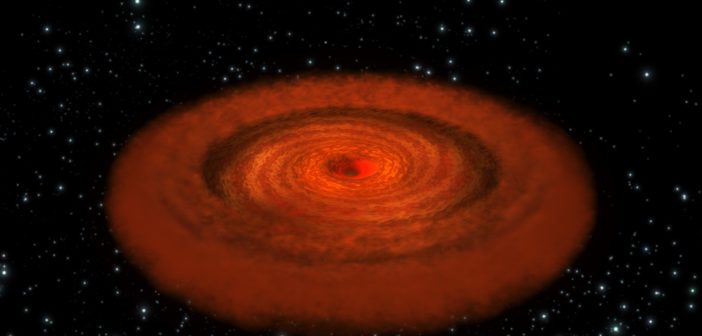Editor’s note: Astrobites is a graduate-student-run organization that digests astrophysical literature for undergraduate students. As part of the partnership between the AAS and astrobites, we occasionally repost astrobites content here at AAS Nova. We hope you enjoy this post from astrobites; the original can be viewed at astrobites.org.
Title: A Population of Bona Fide Intermediate Mass Black Holes Identified as Low Luminosity Active Galactic Nuclei
Author: Igor V. Chilingarian et al.
First Author’s Institution: Smithsonian Astrophysical Observatory and Sternberg Astronomical Institute
Status: Published in ApJ
Most, if not all, galaxies contain a supermassive black hole (SMBH) at their center. But where did these giants come from? Astronomers know that less massive black holes can form when a star collapses in on itself. These stellar-mass black holes can have the mass of a few dozen Suns, but they do not come close to the millions or billions of solar masses SMBHs have.
There are a few ideas for where SMBHs may have come from. One scenario is that the earliest stars left behind small baby black holes, which over time merged together to form more and more massive grown-up black holes that now reside at the center of galaxies. If this were the case, we’d expect to see some teenage, intermediate-mass black holes (IMBHs) — black holes larger than those born from stars but smaller than those we see in the center of galaxies.
Another possibility is that large gas clouds in the early universe collapsed to form massive black-hole “seeds” the size of hundreds of thousands of stellar masses. We then wouldn’t expect to see the adolescent phase of IMBHs, as SMBHs would start growing from these large seeds instead of small ones left behind by stars.
The authors of today’s paper wanted to see if they could find IMBHs, and thus evidence for the first scenario for SMBH formation.
Finding AGNsty Adolescents
While previous searches for IMBHs looked at only a few, pre-selected galaxies, Chilingarian et al. set up an automated search through 1 million catalogued galaxies to look for signs of SMBHs at their centers that are actively gaining mass — objects known as active galactic nuclei (AGN). AGN show distinct spectral lines, as seen in the bottom left of Figure 1. The authors used the width and strength of some of these lines to calculate the mass of the black hole for each galaxy.

Fig 1: The top row shows a diagram breaking down the components of an AGN. The black hole at the center (far right) has an accretion disk emitting light, while the clouds in the broad- and narrow-line regions (center) absorb and reemit the light, causing the peaks seen in the spectra at the lower left. The lower right plots show the curves used to fit the emission lines. [Chilingarian et al. 2019]
By selecting a subset of these candidates for follow-up observations, Chilingarian et al. confirmed the AGN nature of ten of these candidates by detecting them in X-rays. This provided the authors with a sample of ten bona fide AGN with black-hole masses measured between 43,000 and 202,000 solar masses, five of which were previously known. Images of the ten galaxies that host the proposed IMBHs are shown in Figure 2.

Fig 2: Optical images from the Sloan Digital Sky Survey of the ten IMBH host galaxies. The white line shows the scale; five kiloparsecs (kpc) is approximately 1017 kilometers. The red circle is the location of their observations in X-ray wavelengths. The number at the top is their catalogue designation and the number at the bottom is their mass estimate in solar-mass units. The bottom row contains the galaxies with proposed IMBHs found in previous studies. [Chilingarian et al. 2019]
Results
These results are promising for the scenario where supermassive black holes are grown from stellar-mass seeds. If SMBHs grew from seeds larger than these observed intermediate-mass black holes, then we would not expect to see any IMBHs.
From their original sample of 305 possible IMBH host galaxies, 14 currently have enough observational evidence to test the most stringent observing criteria for IMBHs. Only six of those 14 (or 43%) successfully pass all the tests, suggesting that they host a real IMBH. Thus, the authors estimate a lower limit of 131 galaxies in their sample will have real IMBHs when further follow-up observations are performed.
The 305 possible IMBHs the authors explore in this paper are only those that are actively collecting more material. There may be many more non-accreting IMBHs out there that cannot be detected because they are too far away for our current instruments.
The accretion of matter from a host galaxy is not enough to explain the growth of stellar-mass black holes to IMBHs, so IMBHs must form from the merger of smaller black holes. The authors conclude that at least some of the SMBHs we observe must therefore ultimately be built from mergers of small, stellar-mass seed black holes.
About the author, Bryanne McDonough:
First year graduate student at Boston University where I am currently studying the distribution of dark matter and satellites around galaxies using data from the Illustris simulations. My primary research interests are galactic and extragalactic astrophysics using computational methods. Outside of grad school I enjoy reading and crafting.


2 Comments
Pingback: AAS Nova – New
Pingback: Buscando agujeros negros adolescentes | Astrobites en español